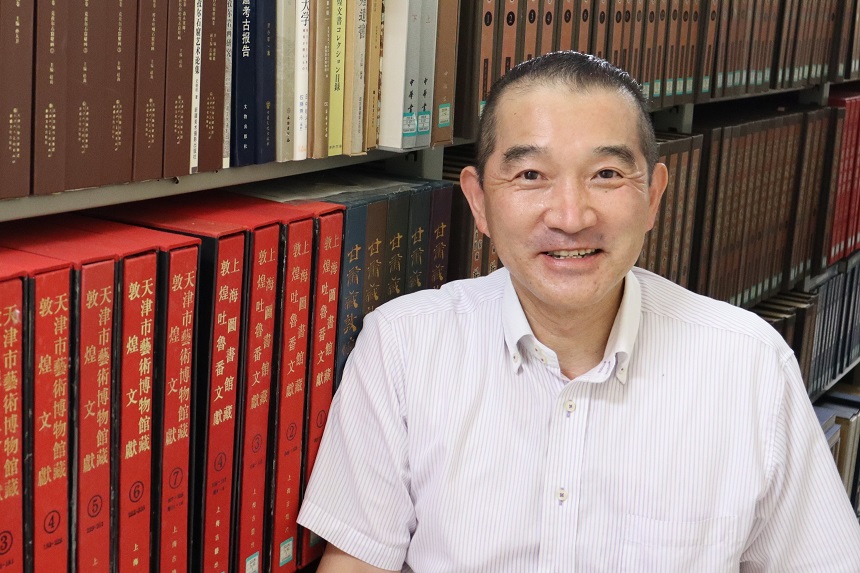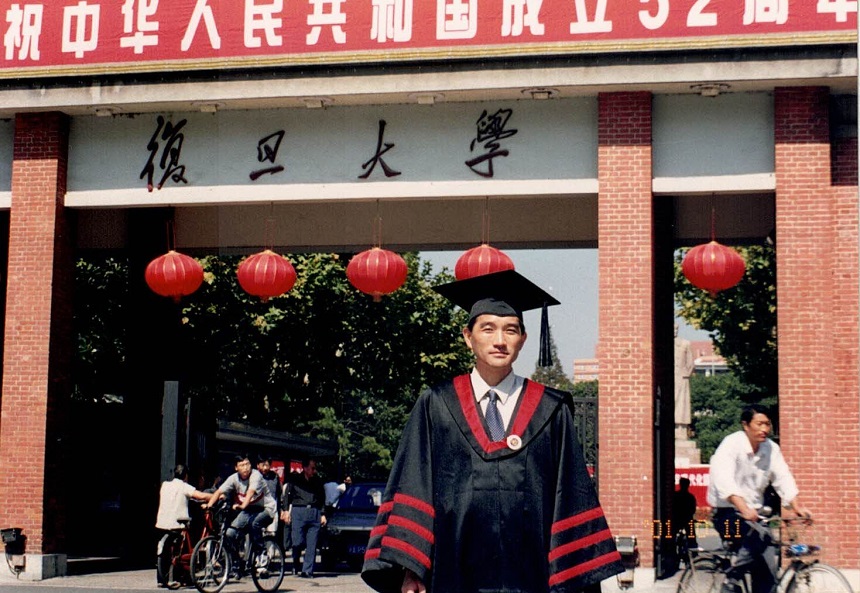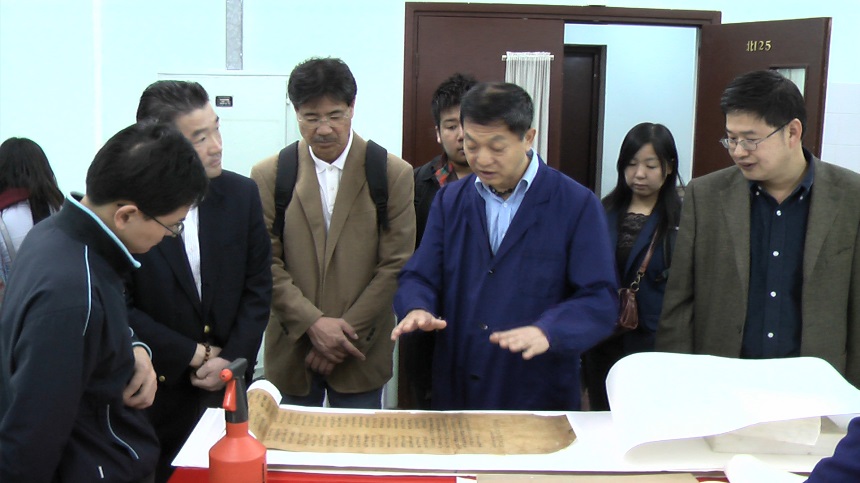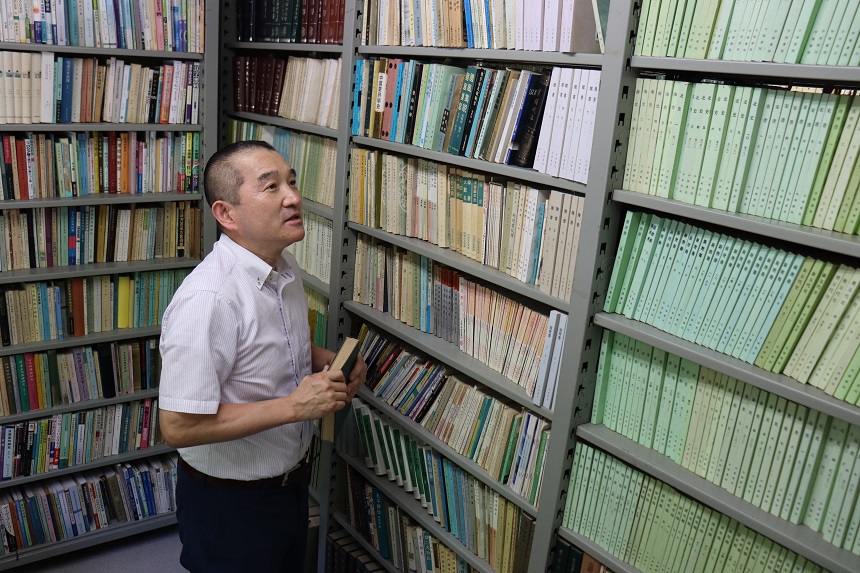On February 1, 2013, Hiroshima University established two new programs: the “Distinguished Professors” (DP) program and the “Distinguished Researchers” (DR) program. Individuals who are part of these programs are recognized as senior and junior faculty members respectively, who are engaged in extraordinarily distinguished research activities.
Interview of Distinguished Professor Hiroshi Arami

An Analysis of the Dunhaung Manuscripts as to Elucidate the Origins of Chinese Popular Literature
New East Asian Exchanges Sketched through Inquiries into Truths Hidden by Conventional Wisdom Depicting New East Asian Exchanges from Inquiries into Truths Hidden in the Conventional Wisdom
How I Became interested in the Dunhuang Manuscripts "Documents of Life"
My research focuses on Chinese literature and philosophy. I was raised in a family whose members had taught the Chinese classics for centuries, from the Edo period (1603–1867) through my grandfather’s day. As such, ever since I was a little boy, I frequently heard the words, "Chinese classics". I had originally planned to study the sciences, but at some points I decided to study the Chinese classics with a special focus on Chinese literature and philosophy. And I suppose I chose that, s because it somehow already felt familiar to me.
At university, I met Professor Shoko Kanaoka, an authority on Dunhuang studies. He sparked my interest, and I became engaged with Dunhuang manuscripts. The Dunhuang manuscripts were unexpectedly discovered in 1900 at a Buddhist site in Dunhuang in western China. They represent an enormous collection of historical records, with some 40,000 manuscripts and texts in scroll form that include materials that appear to date to the Tang period (618–907) and earlier. Such manuscripts that allow us to reproduce documents that were thought to be lost, and their academic value is immeasurable. China even built Imperial Library of Peking (predecessor to today’s National Library of China) so these materials could be brought and stored in Beijing.
One of the reasons why the Dunhuang manuscripts are of interest is because they are what one might call "Documents of Life". Many of the ancient texts still extant today were written by high-ranking people and authorities of the day. What's more, the collection was preserved with the materials arranged with various format by each dynasty. In contrast, there are numerous items among the Dunhuang manuscripts that remain in the same forms used by ordinary people at that time. I fell in love with Chinese classical texts, particularly with Dunhaung manuscripts, so I went to China to study them. I spent more than a decade there engaging in doctoral and postdoctoral studies, and lived the life of a researcher there.

After Professor Arami spent time in the doctoral program at Fudan University, he spent his early years as a researcher in China, which helped him build a network with fellow researchers.
Researching Bianwen: The Genre that Blew a New Wind into Chinese Fiction Studies
I have had a particular interest in what is known as bianwen ("transformation texts"). Starting in the late years of the Tang period, to disseminate Buddhism among the common people, a method of teaching the dharma known as sujiang (lit. "profane explanations") became popular. It entailed describing what the stories told in Buddhist paintings meant in an easy-to-understand fashion. This approach also reached Japan, where it thrived as what was known as e-toki ("picture explanations"). One might even say that it was similar to the early 20th-century form of Japanese street theater known as kamishibai ("paper plays"). Bianwen is thought to have referred to scripts and source books that storytellers would have used for those "profane explanations". It was established as one of the sources for the development of a vernacular literature, and it remains today an important genre in the history of Chinese literature. However, given the fact that it was quite rare for works of fiction written in vernacular language to be recorded over the years, the original bianwen texts did not get archived and they were even forgotten for a time. The discovery of bianwen manuscripts among the Dunhuang manuscripts catapulted them into the limelight and marked the start of bianwen studies. With that being said, bianwen still contains many mysteries. Many basic aspects of it remain unclear, and there are various debates about what those aspects might mean.
Through careful reading of the Dunhuang bianwen manuscripts, I analyzed what sorts of tales are being told and how the people who told those stories at the time changed them for their uses. The tales recorded in these manuscripts are varied. Some contain only parts of a tale, while others connect part of one tale with another resulting in a new story. I was able to clarify the nature of bianwen as a form of narrative literature that continually changed through repeated derivations and summarizations. About 20 years ago, the general understanding in the world of Chinese literature and particularly in research on fiction was that literature using the written word was itself old and had existed in the form of definite original texts. For that reason, my research that brought in the concepts such as "storytellers" and "change" deviated from ordinary research norms. Now, however, it is cited by many. If we think about it, it is quite natural that in the age of the Dunhuang manuscripts when there were no printed matter tales would be handed down as narratives among the common people. From this experience, I once again realized how important it is at times to be skeptical of conventional wisdom in the world of research.
My goal is to expand my perspective to all of East Asia to do work that will lead to a proper understanding
The Dunhuang manuscripts are a valuable collection. It is like a time capsule that takes us back to the world one thousand years ago. Through these materials were handed down generation after generation and changed their form, there are more than a few things that have upended erroneous pieces of conventional wisdom that had been constructed over the years. For example, we can clearly see that Buddhism did not come from India into China to be assimilated in one fell swoop; rather, we can see a pattern in which Buddhism overlaid itself atop ancient Chinese belief and the two fused together.
Furthermore, I am now starting to investigate how Chinese culture was conveyed to Japan. For example, depictions of the gods of wind and thunder are a very interesting subject. Originally, Chinese gods of nature were depicted on ancient gravesites and venerated. However, as belief in Kannon (Ch. Guanyin, Skt. Avalokiteśvara, "Goddess of Mercy") was brought from India and developed in China into belief in the thousand-armed Kannon, these were incorporated into that belief system. There is a separate legion of 28 deities that accompany the thousand-armed Kannon, and in some of these depictions representations of this pair serve as ornamentations placed like the sun and the moon to the left and right in the upper sections of wall paintings and in the small alcoves (known in Japan as butsugan) of cave temples in which Buddhist statues would be placed. It is thought that, around the time that this form of presentation had taken root, it was brought to Japan and there became formalized. Incidentally, back in China, depictions of these gods of wind and thunder with wrestler-like bodies eventually went out of fashion and they instead were transformed into birds. It is interesting that, upon viewing Tawaraya Sotatsu's The Gods of Wind and Thunder, the Chinese are frequently surprised to learn how these deities are depicted.
My plan is to pour my energies into research whose scope is expanded from China to take all of East Asia into view. For example, Chinese characters (Jp. kanji) are another research topic of considerable interest. In China, Korea, and Japan, just by knowing Chinese characters it is easy to assume that you can communicate your intent, but at the same time this also has pitfalls. That's because even with the same characters, if you dig down you will find there are many words whose meanings are slightly different. Even when it comes to scholarly terms, there are many words that we do not have in common with Chinese scholars. For example, in our research on religious culture, even such basic words as kami (god, deity) and shukyo (religion) can result in different interpretations if they are not carefully explained.
I would like to do careful retranslations of classic Chinese works that take into account the difference in understandings and thinking about the background to the words used, as well as the differences in the approaches to understanding of the characters. As the Dunhuang manuscripts have taught us, we have developed many preconceived ideas and misunderstandings over many years of history. There are also some classic texts where I get the feeling, "A Chinese would likely not read it this way". Fortunately, over my long years spent in China, I made friends with many Chinese. My hope is that, while benefiting also from their efforts, I can achieve something that will be useful at least in some small way toward achieving mutual understanding with our friends in neighboring countries.

Professor Arami (second from left) engaging in a lively discussion with fellow scholars while taking part on a visit to the Department of Rare Books, and Special Collection, National Library of China as a member of a study group from Hiroshima University.

Professor Arami surrounded by a vast collection of books he collected while studying in China.

 Home
Home